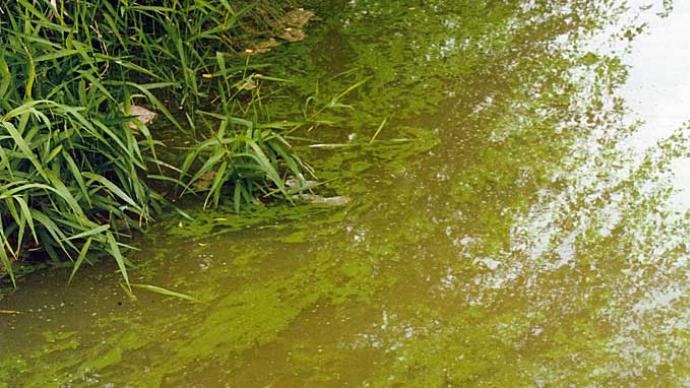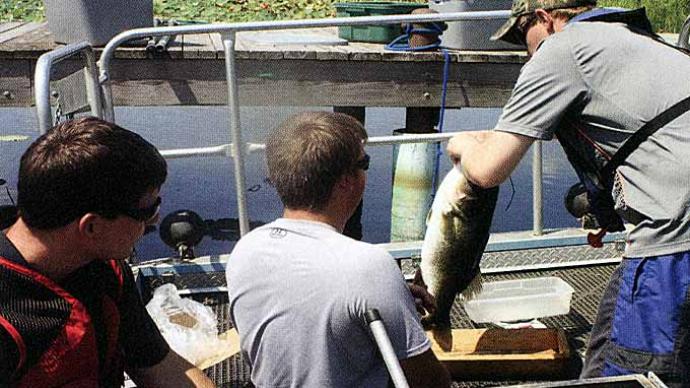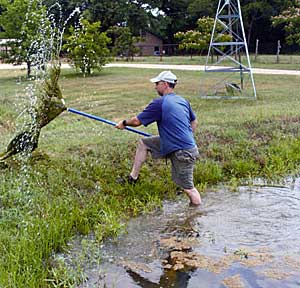
It is the season—for underwater greenery to blast off. This time of year, pond owners often scratch their heads in amazement about the explosion of aquatic plant growth in, around, and under the waters of their precious ponds. Some folks hit the panic button and begin eradicating the stuff, others stand by and watch to see how bad it gets, and the rest think and try to determine the most suitable way to mesh all this underwater salad into their best management practices.
Funny, all three choices could be the best choice, depending on the scenario and goals of the landowner. Not quite as funny—the opposite fact holds true as well—all three of those aforementioned choices might be the worst choices. How do you understand your scenario, so you can choose the best strategy?
"Education is not the filling of a pail, but a lighting of a fire." This quote is misattributed to Irish poet William Butler Yeats, but regardless of who wrote it, this truth is totally applicable to a practical approach to managing aquatic plants, so long as you don't let your pail fill with aquatic plants before igniting the fire of your education.
Here's the skinny about aquatic plants. There are more than 700 species of aquatic plants known in the United States. The point here is to help you gain a fundamental understanding of your plants in order to make the best decisions concerning them without succumbing to either overwhelm or panic.

To keep this primer organized so as not to overfill our educational pail, know that there are several basic zones within your pond where certain species grow. There are free floating plants such as azolla, watermeal, and duckweed. They float. There are those totally submersed plants as naiad and most species of pond weeds. Most of these are rooted, although some are not (coontail and bladderwort come immediately to mind). There are those that are rooted in the pond bottom, but rise to the surface, such as lilies and American lotus. Some emergent plants are rooted in the mud and stick well out of the water such as creeping yellow water primrose, arrowhead, horsetail, and alligator weed. Others can be totally emergent with wet feet. Good examples are cattails and waterwillow. Then, there are stream bank plants as well as species that grow in the moist areas above the water line such as smartweed, willow trees, alders, and cypress.
On the next visit to your pond, see which zones have plants. Then, identify your plants by species. That starts your education and leads to the best decisions.
In a perfect world, your plants live together well, each species living in balanced harmony with each other, with none of the species dominating the others. In our real world, that harmony and balance is fleeting, if it exists at all. Here's where your education in botany influences the decisions of your pond—and your checkbook.
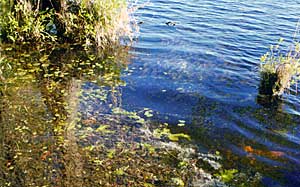
Not all plants are bad. Actually, native species of non-invasive plants in a pond are key components to overall harmony and balance. Remember one of the key tenets in nature— habitat dictates what will thrive. Plant growth is stimulated by habitat, nutrients, temperature, and sunlight. Plants with similar habitat requirements often compete, and if one species gains an advantage, it can dominate. But, with all things being equal, you'll see a variety of plants growing in a similar zone. Sounds like double-talk, but it's really not.
Ideally you would like to see your total aquatic plant coverage, from your pond's bottom ascending to the surface, be less than 15%. The reason we choose 15%? Because too many plants in the wrong zones, especially underwater, can have a negative impact on the rest of what lives beneath the surface. Beyond the shorelines, choose based on goals and aesthetic appeal.
How do you know if plants are becoming a problem? There are several ways to distinguish this dynamic concept. The first answer? Because you think it's a problem. Okay, but just because you think it's a problem, is it really a problem? Here's where you can rely on the biology of the issue, in case you are indecisive or simply don't know.
Job one: Know your goals. If you want to attract waterfowl, more plants are better. If you live in a neighborhood and the homeowners association mows up to the pond's edge, maybe no plants is the mission. If your goal is to manage a fishery, some plants are great, but not too many or too much coverage. If you know your goals, you can evaluate whether you have a problem or not.
Job two: Identify the species of plants in your pond. Some species are non-native, exotic, or invasive. In these cases, these plants aren't what you want. In that perfect world, you want species of plants native to your part of the planet.
Job three: Once you've properly identified your plants, learn what it takes for them to grow and thrive. Compare that knowledge with what your pond offers that plant.
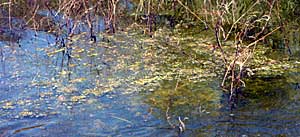
For example, say you've correctly identified American pondweed, curly-leaf pondweed, and coontail growing in your water. The two pondweeds are growing rooted from the bottom in shallow water and you've picked up more than a handful of coontail sprigs seemingly suspended in the water, bumped against some sticks and pondweed plants. Next to the shore, you have yellow water primrose, several bunches of bulrushes, some watershield, and two areas of cattails. Just beyond the shore, you see some young willow trees sprouting in the moist areas. Floating amongst the primrose leaves you see soijie tiny little floating plants you identified as duckweed. What a variety!
Now you need to figure out what this little adventure in science really means and how it affects your pond. Take each species and dig up as much information as you can. Here's some help with the plants in this exercise: American pondweed, where it's not invasive, is a great plant to have. It only grows where the sunlight penetrates. It grows up from the pond bottom, mostly in shallow water, its leaves spread out across the surface, and little seed heads pop up from the top of the water. Tiny fish find shelter amongst the stems and nibble food from the periphyton that grows on the plant. This plant tolerates warm to hot water and expands to a certain density, then stabilizes until fall, when it becomes dormant in cooler water. Sounds like a pretty good plant for your goals.
Curly-leafed pondweed is native to Europe, so it's an exotic plant in your pond. At the same time, it doesn't grow really fast in your waters and dies back when the temperature is hot. Maybe it's acceptable to you.
What about coontail? Its life cycle is a little spooky for your goals. It has no roots, meaning it can grow anywhere in your pond. It's submerged and moves with wind, waves, and currents. It also gleans nutrients from the water. If your pond is a fishing pond, coontail isn't what you want. Not only can it dominate your other plants by covering their space, it can take away food and block the sunlight, preventing some of these more desirable plants from thriving. Sounds like you might want to check this one off the list and go pull those sprigs out of the pond, post haste.
What about that primrose? Seems harmless enough, plus it has those pretty little yellow flowers. How fast does it grow? How bushy will it get? How far out over the pond's surface will it expand? These are all good questions. That's how you decide what to do. It only grows from the pond's edge outward, and if your pond will drop a couple of feet this summer, this might not be a bad plant. If there is also a bit too much shallow water, primrose makes better ground cover than the other plants that might show up. You might choose to leave it, for now. The bulrushes are in bunches and add some nice vertical relief to the shoreline landscape. That one stays. That watershield looks kind of cool, but it quadrupled from last year to this year. What will it do for the rest of the summer? Learn how it expands and reproduces. Then, choose whether it should stay. The cattails seem to be staying put on a silty knoll next to the deepest water. Redwing blackbirds nested there last year. Let's leave those, but keep a close eye on them.
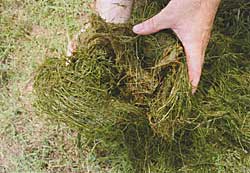
What about those tiny little duckweed plants floating aimlessly amongst the other plants? Quick research suggests this little plant might be your biggest problem if left unchecked. It has something to do with each plant reproducing every 48 hours. A quick count reveals more than 100 of those little double-leafed plants nestled along that plant-lined shore. Hmmm...I remember those equations from high school math, "Would you rather have a million dollars or a penny doubled every day for 30 days?" Look at duckweed as that penny. Willow trees? Research reveals a full-grown willow sucks 100 gallons of water from your pond every hot summer day. Plus, they slough-off their leaves and limbs, grow fast, but don't seem to live very long, compared to other trees we might prefer.
Now that you've learned about these plants, you can decide what, if anything, to do about them. If you live in an arid part of the country, those willow saplings may need to disappear. If you live in the south, that duckweed needs to go away, too. No matter what, that coontail isn't helpful for your goals, so it needs to be taken out for sure. Those other plants look like a nice fit for you, but one or two deserve watching.
Now, you have the genesis of a plan. Some stay, some go, some bear watching. That's the beginning. Next, you need to figure out how to extract the plants that must go. Homework reveals three fundamental ways of dealing with aquatic plants. There are physical removal techniques, biological solutions, and herbicides that will do the job. Next, you study each method; determine how each method affects the plants you want to remove as well as those you want to keep.
Now, you have a plan. Sounds pretty easy? It's not. There are professionals who deal with this stuff every day and even the best ones often have to think through the repercussions of the choices they are about to make. For every choice there is a consequence. Knowing the consequence gives you confidence in the choice you make.
Here's the kicker. The plants are not the problem. They are a symptom of the problem. As you move closer to your best plan of action, keep in mind why those plants are there in the first place—they have the best habitat, nutrients, temperature, and sunlight. If you truly want to manage greenery, understand this fundamental truth, and then use the tools for the best choices.
Like Yeats may have said, if he were a pond manager,
"O aquatic plants is the crooked thing
There is nobody wise enough
To find out all that is in it,
For he would be thinking of strategies,
Biology, growth rates and empathy
Till the stars had run away
And the shadows eaten the coontail."
Reprinted with permission from Pond Boss Magazine

